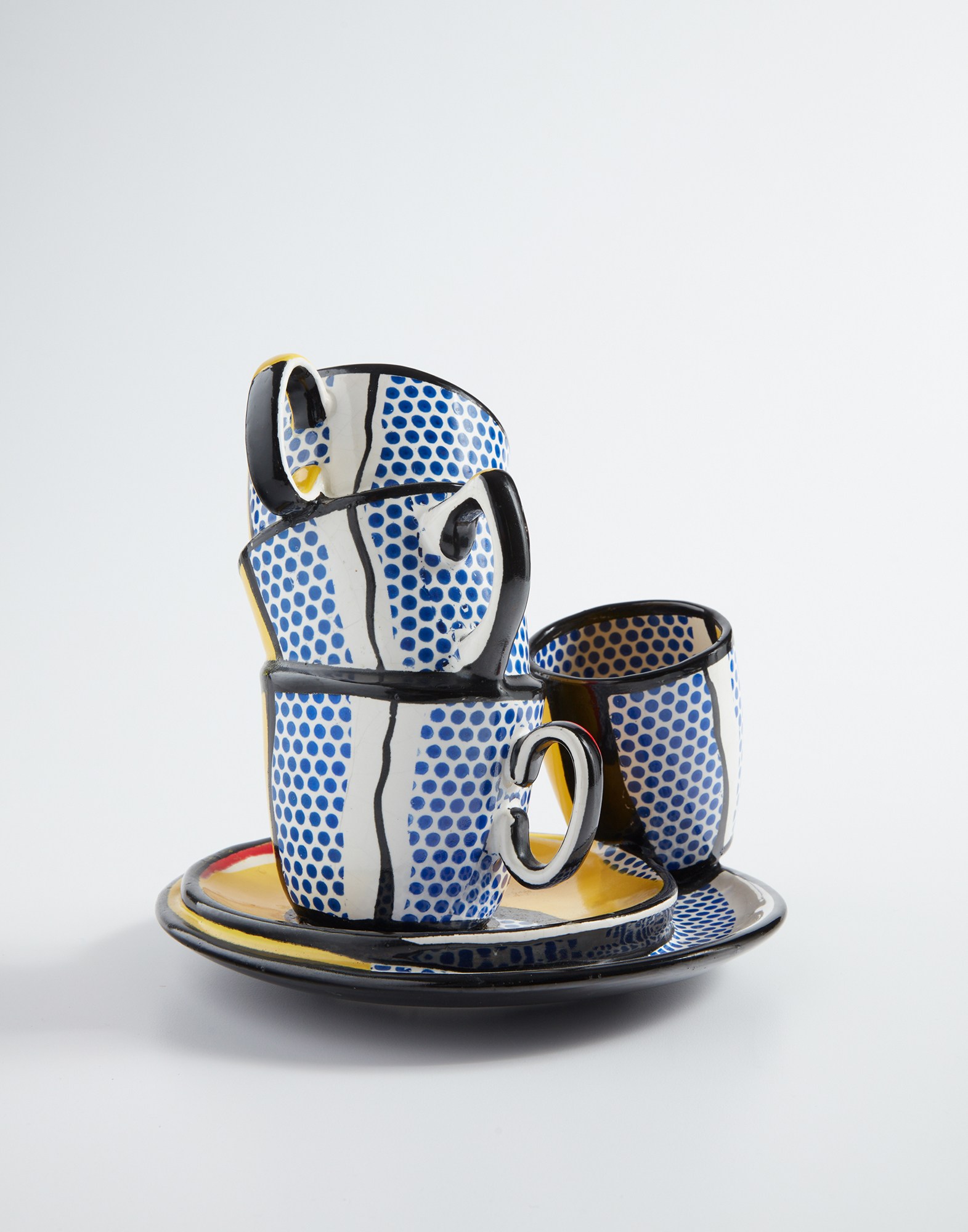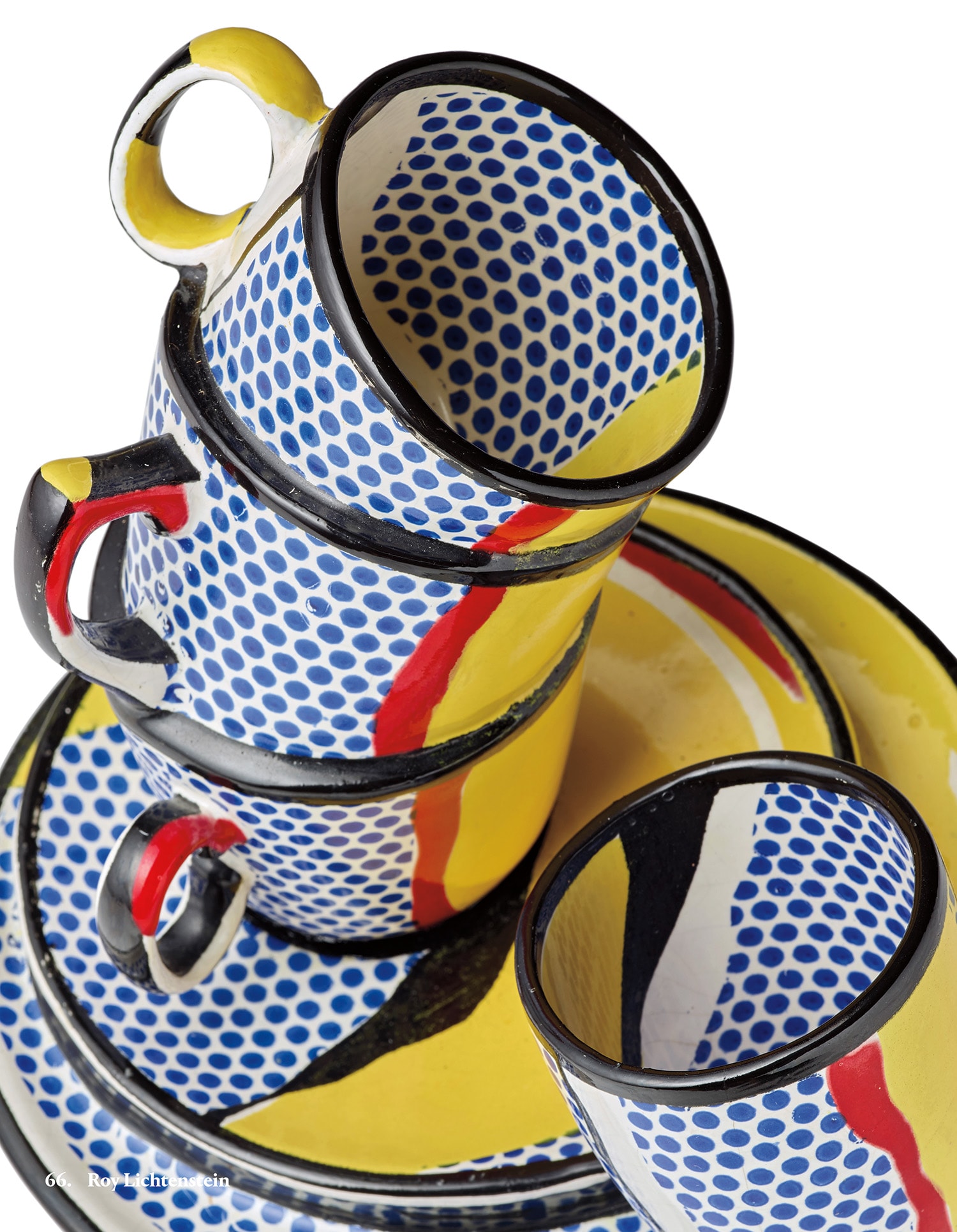







Property of a Distinguished European Collector
66
Roy Lichtenstein
Ceramic Sculpture #10
signed with the artist's initials and dated 'rf Lichtenstein '65' on the underside
painted and glazed ceramic
21.6 x 22.5 x 21.6 cm (8 1/2 x 8 7/8 x 8 1/2 in.)
Executed in 1965.
This work will be included in the catalogue raisonné being prepared by The Roy Lichtenstein Foundation.
This work will be included in the catalogue raisonné being prepared by The Roy Lichtenstein Foundation.
Full-Cataloguing
Bold, playful and innovative, Roy Lichtenstein’s Ceramic Sculpture #10 exemplifies the artist’s multidisciplinary capabilities, translating his unique two-dimensional graphics onto a three-dimensional form. In the present work, Lichtenstein defies the limitations of physical form and blurs the distinction between the dimensional planes of painting and sculpture. Infamously drawing upon the visual language of American consumer culture in the iconic form of the coffee cup, and embellishing it with the colourful aesthetics of advertising that define Lichtenstein’s internationally renowned style, Ceramic Sculpture #10 imbues the most quotidian of forms with a prevailing artistic significance that transforms the familiarity of the everyday object into a sculptural work of high art that toys with our perceptions of reality.
Executed in 1965, Ceramic Sculpture #10 belongs to the Ceramic Sculptures series, a seminal body of work in which Lichtenstein developed his sculptural style in glazed ceramics. Following earlier explorations into sculpture in the 1940s and 1950s, it was only at this point in his career that the artist was seriously pursuing the potential possibilities of three-dimensional creation. Developing the use of ceramic allowed him to more successfully apply his saturated block colours and delineated designs onto a contoured surface. In this way, Lichtenstein bridges the gap between two artistic disciplines: ‘there is really not that much difference aesthetically between two and three dimensions to me. I believe sculpture can be seen as a two dimensional problem … even though I realise it is three-dimensional, it is always a two dimensional relationship to me – or as two-dimensional as drawing is’ (Roy Lichtenstein, quoted in ‘Roy Lichtenstein: A Conversation with Constance W. Glenn’, Roy Lichtenstein: Ceramic Sculpture, exh. cat., The Art Galleries, California State University, Long Beach, p. 17-18). In turn, this created a deceptive interplay between physical and superficial surface contrasts in a dynamic reinvention of the everyday form of the cup and saucer. This subject also resonates with the prevalent American consumer culture, exemplified by diners in the 1950s and 1960s, that inspired Lichtenstein throughout the duration of his career.
The design itself is rendered with the infamous Ben-day dots in a typically vibrant, primary colour palette of red, blue and yellow, set against a white background and delineated by a black outline borrowed from the visual lexicon of comic books, newspapers, magazines and advertisements. The humorous form, a teetering tower of crockery suspended on the brink of toppling, creates a hazardous sense of anticipation. Elevating the functional subject to a work of art, Ceramic Sculpture #10 takes a conventional form and turns it into something extraordinary. Lichtenstein explains: ‘I think ceramics were interesting to people in the way that I would like them to be interesting … I mean, what makes it a sculpture rather than just a stack of dishes. I’m not sure that was understood, but maybe it was felt. I think on a superficial level they were all instantly understood, and I think that’s the way people accepted them’ (Roy Lichtenstein, quoted in ‘Roy Lichtenstein: A Conversation with Constance W. Glenn’, Roy Lichtenstein: Ceramic Sculpture, exh. cat., The Art Galleries, California State University, Long Beach, p. 23). The motif of the coffee cup that appears in his earlier paintings and drawings is reiterated here in ceramic, transposed and subsequently reinvented in sculptural form. As well as referencing his own subject matter, Lichtenstein was also acutely aware of the titans of sculpture - and particularly of ceramics - that preceded him in the twentieth century, such as Pablo Picasso, and was informed by them in his own work. Consider, for example, Picasso’s Glass of Absinthe, 1914, in which indisputable parallels can be seen with the present work; both in subject matter and in style, each is a product of its contemporaneous society and comprises a visually similar use of graphic dots and lines.
In addition to the cultural significance of the subject, the enigmatic appearance of pictorial space in three-dimensional form elevates the object from a conventional product of consumerism to a remarkable work of art that sits at the heart of Lichtenstein’s sculptural output. Continually renewing and redefining his own production, transgressing genres and practices to incorporate his stylistic ingenuity in new and innovative ways, Lichtenstein captures the essence of Pop culture in Ceramic Sculpture #10, a work that exemplifies his
artistic proficiency both as a sculptor and a painter.
Executed in 1965, Ceramic Sculpture #10 belongs to the Ceramic Sculptures series, a seminal body of work in which Lichtenstein developed his sculptural style in glazed ceramics. Following earlier explorations into sculpture in the 1940s and 1950s, it was only at this point in his career that the artist was seriously pursuing the potential possibilities of three-dimensional creation. Developing the use of ceramic allowed him to more successfully apply his saturated block colours and delineated designs onto a contoured surface. In this way, Lichtenstein bridges the gap between two artistic disciplines: ‘there is really not that much difference aesthetically between two and three dimensions to me. I believe sculpture can be seen as a two dimensional problem … even though I realise it is three-dimensional, it is always a two dimensional relationship to me – or as two-dimensional as drawing is’ (Roy Lichtenstein, quoted in ‘Roy Lichtenstein: A Conversation with Constance W. Glenn’, Roy Lichtenstein: Ceramic Sculpture, exh. cat., The Art Galleries, California State University, Long Beach, p. 17-18). In turn, this created a deceptive interplay between physical and superficial surface contrasts in a dynamic reinvention of the everyday form of the cup and saucer. This subject also resonates with the prevalent American consumer culture, exemplified by diners in the 1950s and 1960s, that inspired Lichtenstein throughout the duration of his career.
The design itself is rendered with the infamous Ben-day dots in a typically vibrant, primary colour palette of red, blue and yellow, set against a white background and delineated by a black outline borrowed from the visual lexicon of comic books, newspapers, magazines and advertisements. The humorous form, a teetering tower of crockery suspended on the brink of toppling, creates a hazardous sense of anticipation. Elevating the functional subject to a work of art, Ceramic Sculpture #10 takes a conventional form and turns it into something extraordinary. Lichtenstein explains: ‘I think ceramics were interesting to people in the way that I would like them to be interesting … I mean, what makes it a sculpture rather than just a stack of dishes. I’m not sure that was understood, but maybe it was felt. I think on a superficial level they were all instantly understood, and I think that’s the way people accepted them’ (Roy Lichtenstein, quoted in ‘Roy Lichtenstein: A Conversation with Constance W. Glenn’, Roy Lichtenstein: Ceramic Sculpture, exh. cat., The Art Galleries, California State University, Long Beach, p. 23). The motif of the coffee cup that appears in his earlier paintings and drawings is reiterated here in ceramic, transposed and subsequently reinvented in sculptural form. As well as referencing his own subject matter, Lichtenstein was also acutely aware of the titans of sculpture - and particularly of ceramics - that preceded him in the twentieth century, such as Pablo Picasso, and was informed by them in his own work. Consider, for example, Picasso’s Glass of Absinthe, 1914, in which indisputable parallels can be seen with the present work; both in subject matter and in style, each is a product of its contemporaneous society and comprises a visually similar use of graphic dots and lines.
In addition to the cultural significance of the subject, the enigmatic appearance of pictorial space in three-dimensional form elevates the object from a conventional product of consumerism to a remarkable work of art that sits at the heart of Lichtenstein’s sculptural output. Continually renewing and redefining his own production, transgressing genres and practices to incorporate his stylistic ingenuity in new and innovative ways, Lichtenstein captures the essence of Pop culture in Ceramic Sculpture #10, a work that exemplifies his
artistic proficiency both as a sculptor and a painter.